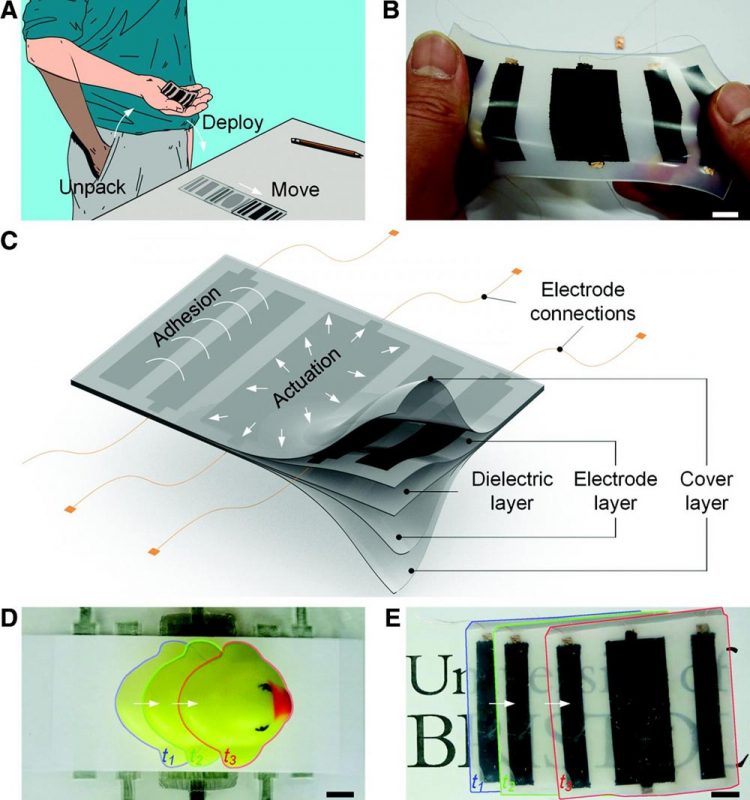Soft skin-like robots you can put in your pocket

Active soft-smart structures with self-actuating, self-gripping, and self-locomoting capabilities. (A) Pocketable and deployable fully soft crawling robot concept. (B) A fully soft ElectroSkin robot stretching in hand. (C) Schematic diagram of the fundamental ElectroSkin design showing regions powered for electroadhesion and actuation. (D) An ElectroSkin conveyor moving a yellow duck on a piece of office paper. (E) A fully soft ElectroSkin robot self-locomoting across a surface. Scale bars denote 1?cm. Credit: Professor Jonathan Rossiter
This new advance, published in Soft Robotics, could create new thin and light robots for environmental monitoring and deployment in hazardous environments, robot grippers for delicate objects and new wearable technologies.
Traditional robots are rigid and incompliant, whereas soft robots are compliant and can stretch and twist to adapt to their environments. Until now, soft robots have separated their movement abilities from their capabilities to grip the surface they move on.
Taking inspiration from biological skins and soft organisms like snails and slugs, researchers from Bristol's Faculty of Engineering, led by Professor of Robotics Jonathan Rossiter, have successfully demonstrated a new robotic skin that crawls across a surface by alternately contracting embedded artificial muscles and gripping the surface using electrical charges.
In the paper, the team describe how a robot made from the skin, called ElectroSkin, can be scrunched up, put in one's pocket and then later pulled out and thrown on a surface where it moves. ElectroSkin is a new fundamental building block for a range of soft next generation robots.
In the future, ElectroSkin robots could crawl up walls and across ceiling to clean them, explore difficult to reach environments including collapsed buildings, and be used in a range wearable second-skin devices.
Professor Rossiter said: “ElectroSkin is an important step toward soft robots that can be easily transported, deployed and even worn. The combination of electrical artificial muscles and electrical gripping replicated the movements of animals like slugs and snails, and where they can go, so could our robots!”
###
Paper: All-Soft Skin-Like Structures for Robotic Locomotion and Transportation, Jianglong Guo, Chaoqun Xiang, Andrew Conn, and Jonathan Rossiter, in Soft Robotics https:/
Media Contact
All latest news from the category: Interdisciplinary Research
News and developments from the field of interdisciplinary research.
Among other topics, you can find stimulating reports and articles related to microsystems, emotions research, futures research and stratospheric research.
Newest articles

Silicon Carbide Innovation Alliance to drive industrial-scale semiconductor work
Known for its ability to withstand extreme environments and high voltages, silicon carbide (SiC) is a semiconducting material made up of silicon and carbon atoms arranged into crystals that is…

New SPECT/CT technique shows impressive biomarker identification
…offers increased access for prostate cancer patients. A novel SPECT/CT acquisition method can accurately detect radiopharmaceutical biodistribution in a convenient manner for prostate cancer patients, opening the door for more…

How 3D printers can give robots a soft touch
Soft skin coverings and touch sensors have emerged as a promising feature for robots that are both safer and more intuitive for human interaction, but they are expensive and difficult…





















